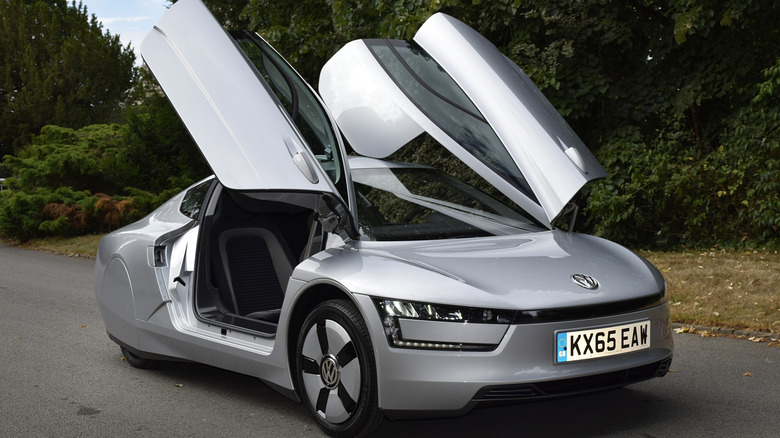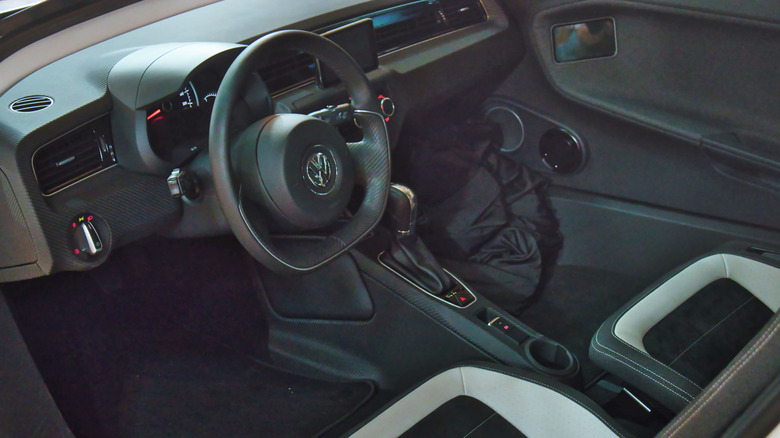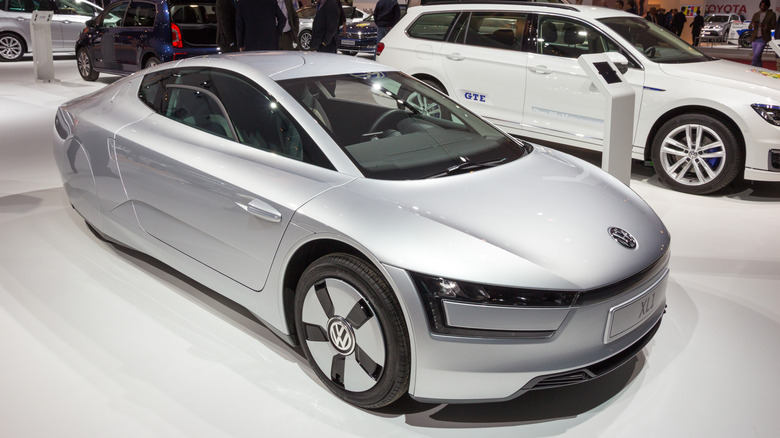How Much Horsepower Did The Volkswagen XL1 Have?
It certainly wasn't the best-looking car out there, that was for sure. But how about those sweet butterfly doors? No? Well, it could achieve 261 miles per gallon, which is still remarkable to this day. Still no? How about that 12-second zero-to-60 time? If you haven't caught up yet, we're talking about the XL1, Volkswagen's limited-production ultra-fuel-efficient hybrid car. Initially unveiled in 2002 as the 1L concept car, Volkswagen officially commenced production of the XL1 in 2013. The company planned to produce only 250 of these vehicles, and although it did, the buzz around them wasn't as spectacular as one might have thought, given that only 200 of them were ever sold.
The XL1 had an 800-cc two-cylinder TDI turbo-diesel engine capable of generating 47 horsepower. Additionally, it featured a 20-kilowatt electric motor, equivalent to 27 horsepower, bringing the vehicle's total horsepower to a meager 69 horsepower. Let's examine the XL1's specs, explore why it was revolutionary at its conception, and why it never quite took off, despite its sweet butterfly doors.
How did it achieve 261 miles per gallon?
For many automotive companies, the goal is usually to push the envelope of what vehicles can do. From hypercars and supercars that blend the most beautiful designs known to man with the greatest motors ever built, to high-tech flying motorcycle concepts that can traverse land, water, and the sky, the only limit is usually the creator's imagination. But only a few concept cars ever make it into production, despite many of them being truly remarkable. This was the case with the XL1, which Volkswagen had promoted as the world's most fuel-efficient production car.
On paper, the XL1 could go 62 miles on just 0.9 liters of fuel, which translates to the 261 miles per gallon the car has become synonymous with. The automaker paired the car's diesel engine and electric motor with a 5.5-kilowatt-hour lithium-ion battery and a seven-speed DSG dual-clutch automatic transmission, enabling the vehicle to achieve a comfortable cruising speed of 62 mph while only using 8.3 horsepower. According to Volkswagen, the car could also operate as an all-electric vehicle for up to 31 miles.
It was the future of fuel-efficient vehicles
At the time of its conception, the XL1's extreme fuel efficiency made it groundbreaking. By the time the car went into production, several features and systems worked in tandem to bring this aspect of the vehicle to life. One of the main features, of course, was its hybrid powertrain. However, its weight and aerodynamic design also played a significant role in enabling the vehicle to use as little fuel as possible. The XL1 weighed just 1,753 pounds, thanks to lightweight materials such as carbon fiber-reinforced polymer used in its construction. Additionally, the car had a drag coefficient of just 0.189 due to its streamlined teardrop shape. So, why did Volkswagen only sell 200 out of the 250 XL1s it produced?
You could argue that Volkswagen's Dieselgate scandal played a part. The controversy tarnished the company's name, directly impacting its overall sales and customer confidence. The XL1 might have found itself mired in the issue, stopping Volkswagen from selling all of its stock. The car's $130,000 (around $178,500 in today's money) price tag might also have spooked many potential buyers. Additionally, there were more viable and accessible eco-friendly options, such as the Honda Insight and Toyota Prius.


